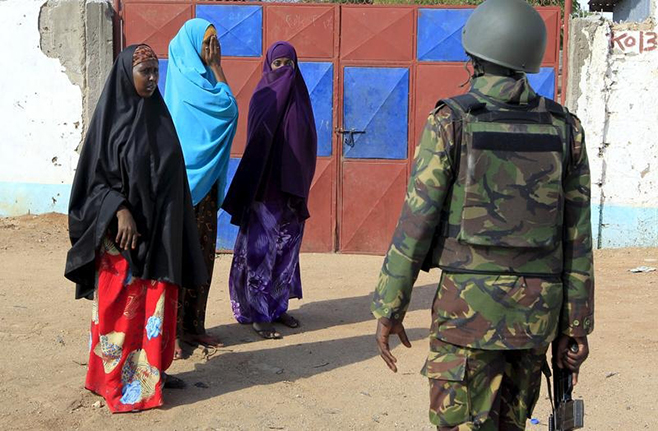Source: Human Rights Watch
(Nairobi) – The abominable attack on Garissa University College in northeastern Kenya requires a measured response by Kenyan security forces to bring to justice those responsible and prevent further attacks. At least 147 have been confirmed dead and 80 injured in the attack on April 2, 2015.
“This despicable attack on students shows contempt for human life,” said Leslie Lefkow, deputy Africa director at Human Rights Watch. “To counter the threat effectively, Kenyan security forces should ensure a lawful response in line with human rights.”
Armed gunmen attacked Garissa University College at about 5:30 a.m. on April 2, according to media reports. Al-Shabaab, the armed Islamist group based in Somalia, claimed responsibility for the attack to journalists and posted a statement on its website.
The scale of the incident – Kenya’s worst terrorist attack since the 1998 bombing of the United States embassy, which killed 213 – became clearer as survivors fled the buildings during the course of the day. Gunmen held dozens of students and employees of the college hostage for hours.
By nightfall the government confirmed that 147 had died, and that the siege was over. Retrieving the bodies from the university building where the hostages were held continued overnight, and the number of dead reached 170 on April 3 according to an independent source in Garissa. The cabinet secretary for interior and national coordination, Joseph Nkaissery, announced that all four gunmen involved in the attack had been killed by Kenyan security forces.
Accounts from residents and eyewitnesses to the attack suggested that many of the victims were killed indiscriminately, at least in the initial phase of the crisis.
A 26-year-old man, Ibrahim Ismail, who lives three kilometers from the university, told Human Rights Watch, “Al-Shabaab is lying that they freed Muslims. One of the guards killed in the attack was a Muslim.” A 42-year-old father of three and human rights activist in Garissa county agreed. “We have relatives at the university who were not spared by Al-Shabaab. This has been a big blow to all of us. They were clearly targeting all civilians no matter the religion.”
Media accounts of other witnesses described instances of the attackers singling out Christian students for killing during the siege.
Garissa University College was established several years ago as an extension college of the Rift Valley-based Moi University, part of a government attempt to open up the largely marginalized northeast region, which is dominated by ethnic Somali Muslims. Although a majority of its estimated 900 students were reportedly from other parts of Kenya, the university has many students from the region as well.
Al-Shabaab bombings and attacks in Somalia’s capital, Mogadishu, and other government controlled towns frequently target, kill, and wound civilians. Most recently, on March 27, a complex attack on a high-profile hotel in Mogadishu killed at least 14 people.
Al-Shabaab regularly recruits and uses children, and has attacked students, schools, and other education facilities. For example, in December 2009, a suicide bomber killed 19 people at a graduation ceremony of medical students in Mogadishu. In October 2011, Al-Shabaab claimed responsibility for a bombing in Mogadishu which killed 70, including students awaiting exam results at the Ministry of Education.
“This would not be the first time Al-Shabaab has deliberately targeted students, schools, and education facilities,” said Lefkow. “Whether in Somalia or in Kenya, there is never any justification for attacking young people who want to study and learn in safety.”
Kenya has faced increased attacks targeting civilians since October 2011, when its troops entered Somalia in the context of military operations against Al-Shabaab. The armed group has claimed responsibility for several large-scale attacks in Kenya in the past 20 months, including the September 2013 attack on Westgate, an affluent shopping mall in Nairobi, in which 67 people were killed, and two attacks in Mandera county in late 2014, in which a total of 64 people were killed. These incidents gained international attention, but smaller attacks have been a regular feature in Kenya’s northeast for several years.
Kenya’s efforts to tackle rising insecurity have been marred by serious human rights violations, includingextrajudicial killings, enforced disappearances, arbitrary detentions, and torture by security forces.
Concerns over security force abuses and discriminatory treatment of Muslim and ethnic Somali communities have been particularly prominent in Kenya’s northeast, its coastal region, and in Nairobi’s Eastleigh neighborhood. Kenyan police and soldiers have repeatedly arbitrarily arrested and mistreated Kenyan citizens and Somali refugees in the northeast, including in the Garissa vicinity, in response to attacks by militants suspected of links to Al-Shabaab.
Calls for investigations of security forces abuses and recommendations for comprehensive reforms, including from Kenya’s Independent Policing Oversight Authority (IPOA), have been largely ignored by the government.
“The shock and anger provoked by this attack is entirely understandable, but the government should avoid knee-jerk responses that undermine rights,” Lefkow said. “Law enforcement operations that respect Kenyan and international law are essential.”


